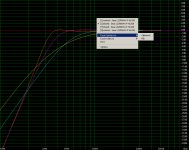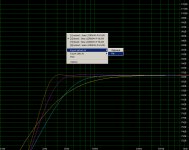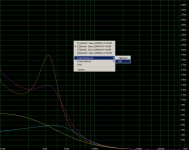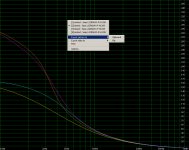The phase shift of a single pole filter is 90degrees out at infinity.
At the turn over frequency the phase shift is 45degrees.
Please explain your 180 and 360 numbers.
Andrew,
Your mistake is that in reality a sealed enclosure is a 2nd order highpass and a BR a 4th order. Sealed therefore at 'turn over frequency' has a phase shift of 90 degrees and a total phase shift of 180 degrees, BR respectively 180 and 360.
Really, you just keep on throwing the wrong kind of information into this thread, without even bothering to quote any sources. Please, take the effort to research first, then come back again with quotes, links, or measurements. Right now, you are just insisting on your erroneous view on this topic, which does not enhance anyones knowledge, including your own.
vac
I know that a sealed box speaker has a 2pole roll off.
I have never stated otherwise.
It is your 180degree and 360degree phase shifts that I have asked you to explain.
I have never stated otherwise.
It is your 180degree and 360degree phase shifts that I have asked you to explain.
You have this bit correct. No argument here.Sealed therefore at 'turn over frequency' has a phase shift of 90 degrees
Last edited:
You are making an arbitrary assumption based on theory which is, I think, inapplicable here. Real world measurements suggest as much.But group delay IS the same as the resonant system decay, constant inertia and accn force mean that the 'attack' part of the emission envelope is equal to the 'decay' part.
Please go there: Resolution, where you may download full-range (rather than gated) anechoic cascading spectrum decay plots for several well-regarded speakers.
The variety in the shapes and durations of vent resonance tails defies belief. Some keep ringing happily well beyond 100 ms (the measurement limit) with little apparent intent to die down and be gone. This is to be expected, as the resonating air column is supposed to try and damp itself; hardly an ideal choice of damper. Some seem to twist and turn their eigenfrequency hither and thither.
The group delay parameter cannot be seen well in these particular graphs, but can be visually inferred: at around the vent res. frequency: unlike what happens in higher frequencies, the earliest part of the LF portion of the plot is invisible as it is hidden behind the ridge formed by later, louder arrivals. This seems to co-variate rather smoothly with frequency, in a manner more or less predictable by theoretical Q, it therefore seems to conform well with predicted group delay.
The decay part, however, evolves rather autonomously over time, in some of the designs at least, and in a manner quite asymmetrical to the 'attack' part. Others are better behaved.
Such erratic behavior cannot be explained away by standard harmonic oscillation analysis and in some cases it seems to have been completely ignored (presumably by designers with no access to anechoic measurements).
There is clearly a complex interaction between many parameters here, and it may have not been given its due attention.
Last edited:
I know that a sealed box speaker has a 2pole roll off.
I have never stated otherwise.
But why then do you post stuff like:
"The phase shift of a single pole filter is 90degrees out at infinity.
At the turn over frequency the phase shift is 45degrees.
Please explain your 180 and 360 numbers."
When there is no kind of enclosure that behaves like a single pole filter; second pole is lowest as in a sealed enclosure?
And why do you post (#13) that:
"Now that you have explained that, I am even more convinced that your statement is not true."
So, you go around posting that my statements are not correct, subsequently you confuse the issue, and in the end you want me to believe that you knew all along what I stated in the beginning, in spite of your initial disagreement with me.
I think there are rules to this,
Vac
What you have been posting and this post43 show that you did not read what I was posting.
You were jumping to conclusions that were not based on any evidence.
Even when prompted to go back and re-read what I posted you still came back arguing that I had got it all wrong and that I needed to do more research.
All this unnecessary argument just because you won't read what is posted !
Are we agreed that a single pole filter has 45degrees phase shift at the turn over frequency?
Does that lead to the conclusion that a 2pole filter has 90degrees of phase shift at the turn over frequency?
Can that last be extended to a sealed box?
Then it seems that we could be homing in on:-
a sealed box having 90degrees of phase shift at the turn over frequency.
That is why I asked you to explain how you came to state 180degrees of phase shift.
If you are not sure, go back and read post8 and see what you posted and what I asked.
You were jumping to conclusions that were not based on any evidence.
Even when prompted to go back and re-read what I posted you still came back arguing that I had got it all wrong and that I needed to do more research.
All this unnecessary argument just because you won't read what is posted !
Are we agreed that a single pole filter has 45degrees phase shift at the turn over frequency?
Does that lead to the conclusion that a 2pole filter has 90degrees of phase shift at the turn over frequency?
Can that last be extended to a sealed box?
Then it seems that we could be homing in on:-
a sealed box having 90degrees of phase shift at the turn over frequency.
That is why I asked you to explain how you came to state 180degrees of phase shift.
If you are not sure, go back and read post8 and see what you posted and what I asked.
Last edited:
Going back to the example: Seas L22RN4X-P
So back to the subject of sealed with low Qts speakers and the example the Seas L22RN4X-P (As it was very low in Qts).
I include plots.
Orange = 40 Litres Reflex.
Yellow = 40 Litres Sealed.
Blue = 15 Litres Sealed.
Pink = 24.7 Litres Reflex.
Are the main advantages of a bass reflex has are the lower theoretical -3 Db point, and the 3-4.5 db advantage at the end of the frequency range?
In practice sealed boxes are often half the size, and equalization could compensate for one bass reflex, given the same box size. So much for theories what about experiences?
The design principle I am thinking of is for my second Quad ESL 63 sub-woofers design, (the first is nearing completion and bigger than I imagined) and the Quad ESL 63 is already a big speaker. Though I doubt I will use a metal code driver like the Seas L22RN4X-P.
So back to the subject of sealed with low Qts speakers and the example the Seas L22RN4X-P (As it was very low in Qts).
I include plots.
Orange = 40 Litres Reflex.
Yellow = 40 Litres Sealed.
Blue = 15 Litres Sealed.
Pink = 24.7 Litres Reflex.
Are the main advantages of a bass reflex has are the lower theoretical -3 Db point, and the 3-4.5 db advantage at the end of the frequency range?
In practice sealed boxes are often half the size, and equalization could compensate for one bass reflex, given the same box size. So much for theories what about experiences?
The design principle I am thinking of is for my second Quad ESL 63 sub-woofers design, (the first is nearing completion and bigger than I imagined) and the Quad ESL 63 is already a big speaker. Though I doubt I will use a metal code driver like the Seas L22RN4X-P.
Attachments
The father of all closed box systems, Acoustic Research, used a low Qts 11 inch driver in it's infamouse AR3a. I know because I've refoamed, reconed and repaired many of these woofers and restored many 3a's.
Fs about 18-20 hz with a Qts of about 0.25 yielded an Fs of 40 hz in a 0.64 cu.ft box. and the rest is history.
Fs about 18-20 hz with a Qts of about 0.25 yielded an Fs of 40 hz in a 0.64 cu.ft box. and the rest is history.
What you can do is to use a long throw woofer suitable for a sealed box, put a L-T circuit on it and then adjust the q with first order filters.
A typical Northern hemisphere dwelling is said to have around 6db. per octave pressurisation gain bellow 40Hz..
If for instance you put a L-T that goes flat down to 30Hz. and a first order filter at 40Hz. then in this typical situation the result will be flat to 30Hz, you can then use a first order filter to get a roll off q value that you want.
rcw
A typical Northern hemisphere dwelling is said to have around 6db. per octave pressurisation gain bellow 40Hz..
If for instance you put a L-T that goes flat down to 30Hz. and a first order filter at 40Hz. then in this typical situation the result will be flat to 30Hz, you can then use a first order filter to get a roll off q value that you want.
rcw
You are making an arbitrary assumption based on theory which is, I think, inapplicable here. Real world measurements suggest as much.
Please go there: Resolution, where you may download full-range (rather than gated) anechoic cascading spectrum decay plots for several well-regarded speakers.
The variety in the shapes and durations of vent resonance tails defies belief. Some keep ringing happily well beyond 100 ms (the measurement limit) with little apparent intent to die down and be gone. This is to be expected, as the resonating air column is supposed to try and damp itself; hardly an ideal choice of damper. Some seem to twist and turn their eigenfrequency hither and thither.
The group delay parameter cannot be seen well in these particular graphs, but can be visually inferred: at around the vent res. frequency: unlike what happens in higher frequencies, the earliest part of the LF portion of the plot is invisible as it is hidden behind the ridge formed by later, louder arrivals. This seems to co-variate rather smoothly with frequency, in a manner more or less predictable by theoretical Q, it therefore seems to conform well with predicted group delay.
The decay part, however, evolves rather autonomously over time, in some of the designs at least, and in a manner quite asymmetrical to the 'attack' part. Others are better behaved.
Such erratic behavior cannot be explained away by standard harmonic oscillation analysis and in some cases it seems to have been completely ignored (presumably by designers with no access to anechoic measurements).
There is clearly a complex interaction between many parameters here, and it may have not been given its due attention.
To the most part I agree with you. believe it or not. 100m,s decay is quite believeable. but then 100ms 'room' decay is also quite believable and this could exist whether the box is vented or sealed. that was my point. I actually like sealed better in certain apps.
Gretaer point: as other have said, sim response and if acceptable then go sealed. If not look around for a different driver or go vented. simples
- Status
- This old topic is closed. If you want to reopen this topic, contact a moderator using the "Report Post" button.
- Home
- Loudspeakers
- Multi-Way
- Sealed with low Qts



